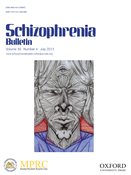-
PDF
- Split View
-
Views
-
Cite
Cite
John L. Waddington, Peter F. Buckley, Psychotic Depression: An Underappreciated Window to Explore the Dimensionality and Pathobiology of Psychosis, Schizophrenia Bulletin, Volume 39, Issue 4, July 2013, Pages 754–755, https://doi.org/10.1093/schbul/sbt083
Close - Share Icon Share
In historical context, the classification and consideration of psychotic depression vis-à-vis schizophrenia and bipolar disorder has long been both unsatisfactory and contentious. Set against the backdrop of a continuum of depressed mood, from normal reaction to life events (eg, bereavement) through to severe depression with marked anhedonia, psychomotor retardation, and neurovegetative changes (so-called melancholia), we have struggled to understand the diversity of mood disorder. Furthermore, we have struggled to determine whether we can tease out distinct subgroups of etiological significance or, alternatively, whether in reality these reflect manifestations along a continuum of severity.1 Within this schema, psychotic depression has long been considered the most severe form of depressive illness,2 a conceptualization that positions psychotic depression as distinct and potentially independent of other major psychoses, most notably schizophrenia and bipolar disorder. Thus, psychosis research currently wrestles to reconcile traditional concepts of categorical diagnosis with contemporary evidence favoring a dimensional approach to nosology, pathobiology, and treatment.
Our field has evolved from classical debates, such as the relationship between schizophrenia and schizoaffective disorder, to a contemporary situation where multiple empirical studies and meta-analytic reviews now focus, at several levels, on the relationship between schizophrenia and bipolar disorder. Yet one component of psychotic illness, despite having the potential to be equally (if not more) informative on these challenges, is conspicuous in its neglect: major depressive disorder with psychotic features (MDDP). Persons experiencing the emergence of psychosis on a background of major depressive disorder reflect most starkly the co-occurrence of categories of psychotic and affective diagnosis and typify most robustly the intersection of psychotic and affective dimensions of psychopathology. Thus, it remains enigmatic that MDDP has received so little systematic investigation.
Emergent evidence for underlying neurobiological similarities among psychotic diagnoses, coupled with effort to understand mental disorders through the framework of neuroscience,3 now provide a propitious environment to reconsider the nosological status and pathobiological implications of MDDP vis-à-vis schizophrenia and bipolar disorder. Moreover, these deliberations represent some of the more fundamental challenges and opportunities that underlie the development of the Diagnostic and Statistical Manual of Mental Disorders-5 (DSM-5) revision process.4–6
Several important studies are now providing increasing understanding of MDDP in a manner complementary to the far more numerous studies of schizophrenia and bipolar disorder. This theme brings together leading investigators to define our current knowledge on MDDP, particularly prospective studies following a first psychotic episode on a background of major depressive disorder, in terms of epidemiology and clinical characteristics, genetics, structural and functional neuroimaging, and treatment. Each author will compare findings at these differing levels of investigation vis-à-vis current knowledge of schizophrenia and bipolar disorder, and, as we prepare for DSM-5, synthesize the findings vis-à-vis current debate as to categorical vs dimensional models.
The authors give careful and thoughtful consideration to these comparisons: Owoeye et al7 describe the prospective evaluation of a first psychotic episode on a background of major depressive disorder, to elaborate its epidemiology and clinical characteristics; Domschke8 brings together an unforgiving literature on the genetics of MDDP, in terms of both clinical and molecular genetics; Busatto9 summarizes both structural and functional brain imaging findings on MDDP; Rothschild10 addresses the vexing topic of treatment of MDDP, primarily the relative roles of antidepressants and antipsychotics given alone or in combination. Collectively, these articles emphasize the current need and opportunity for a timely reappraisal of our conceptualization of psychosis by incorporating MDDP alongside schizophrenia and bipolar disorder. They open an underappreciated window through which to illuminate further the dimensionality and pathobiology of psychotic illness.
References




